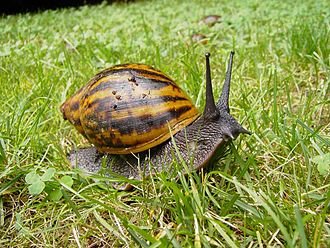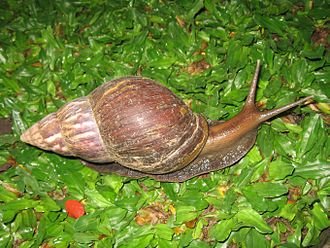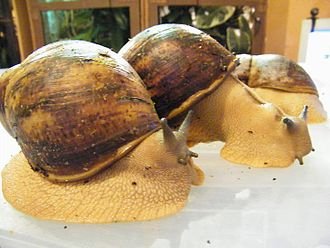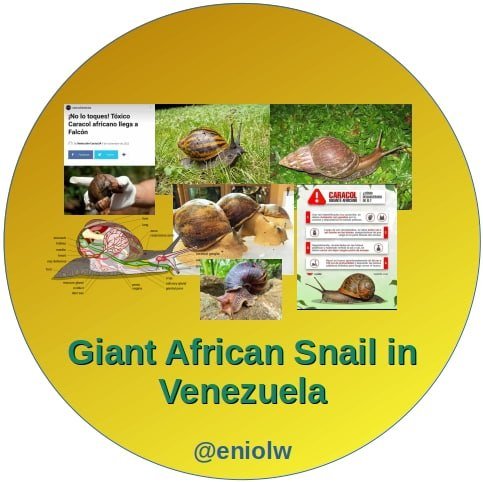
The giant African snail in Venezuela - What is it and why the concern?
By Enio...
Recently, it was reported a large-scale appearance in Venezuela of the snail popularly known as the giant African snail. Social media and messaging apps were flooded with posts and videos about it. They talk about the presence of the animal in semi rural communities and even urban sites, as well as warnings and guidelines from health institutions, a lot of spamming speculation and, of course, memes and jokes.
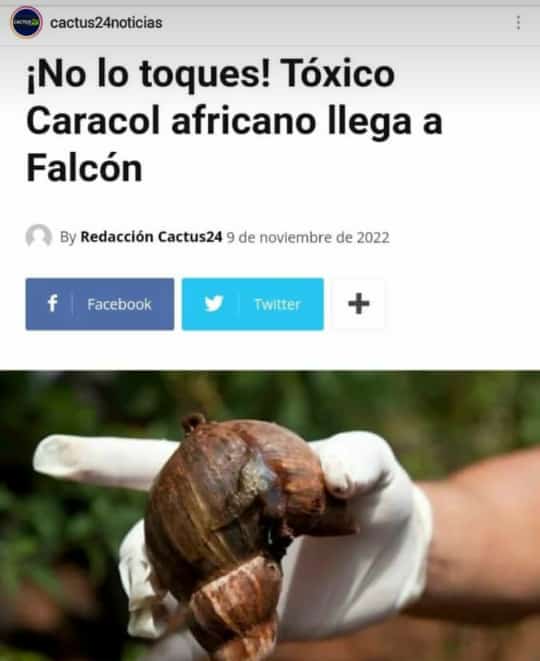
⬆️ Popular report circulating on the social media. Its headline says: "Don't touch it! Toxic African snail arrives at Falcon [a Venezuelan state]"

⬆️ Informative charts circulating on the social media. It's titled: "Giant African snail. How to get rid of it?"

⬆️ People from semi-rural communities explaining on video how to get rid of the invasive snail (the tik tok channel is named inside the image. The video label says "How to kill the African snail in Venezuela").
Venezuelans are often heard to say that their sense of humor is "special", and therefore they don't stop joking that the blessed snail is nothing more than another "plague of Egypt" (in reference to the popular mythical story from the bible) that has descended upon the country; plagues that include untalented politicians, inflation, the Covid-19 pandemic, the rainy season with devastating effects and now the exotic snail.
It is fair to say that one part of the Venezuelan population is alarmed by the information spread about this snail, where some local health authorities have instructed how the animal should be treated and neutralized, which in a nutshell consists of collecting the specimens using gloves (or other means to prevent contact with the skin), placing them in a bucket of salted water and, once dead, burying them at least 50 cm deep.
However, what do we know about this snail? Why the phobia towards it? Is its extermination justified? Is the popularized method of killing them really "humane"? Don't these animals suffer for it? In this first installment we will answer the first three questions posed, where we will learn several details and fun facts that I think are educational for the general public and that I personally find interesting from a scientific point of view.
A little about the giant African land snail
To begin with, we are not talking about a single species of snail, but about a group of them. The name giant African snail is rather a common name that we use to refer to several species of snail, since almost nobody uses colloquially the scientific names in Latin, like Achatina achatina, Lissachatina fulica and Archachatina marginata which are the best known established species.
They're cute, ¿aren't they? Of these, the second one listed is the species that has proliferated in Venezuela recently as we will see below.
In taxomomy, snails are classified, among other forms, as gastropod mollusks. As mollusks, their most distinctive feature is that they are invertebrate animals, i.e. they do not possess a skeleton of bone, let alone a backbone. They are closely related to other easily recognizable animals, such as slugs, oysters and even octopuses.
As for the category of gastropod, this literally means "stomach foot". You see, much of the snail's visible anatomy consists of a single foot, which is the large muscle it uses to move around, and it is "stomachic" since its appearance is slimy and gross, resembling the contents of the stomach, yuck!
Not true! Although it's definitely a plausible and didactic way of looking at it. Actually, they are called gastropods since the snail organs have been twisted in such a way that the digestive tract is located on the underside of the body, just above the foot, and in some cases the anus is above the mouth.
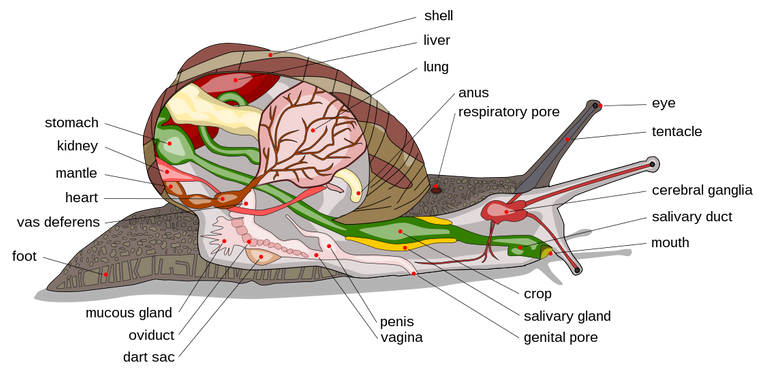
⬆️A little of the snail anatomy. You can see its digestive track in green (Picture: Wikimedia Commons).
They are said to be gigantic since they can reach considerable sizes compared to their relatives. In fact, one specimen of the giant African snail Achatina achatina is the current Guinness World Record holder for the largest land snail ever, measuring 39.3 centimeters from snout to tail and weighing almost one kilogram.
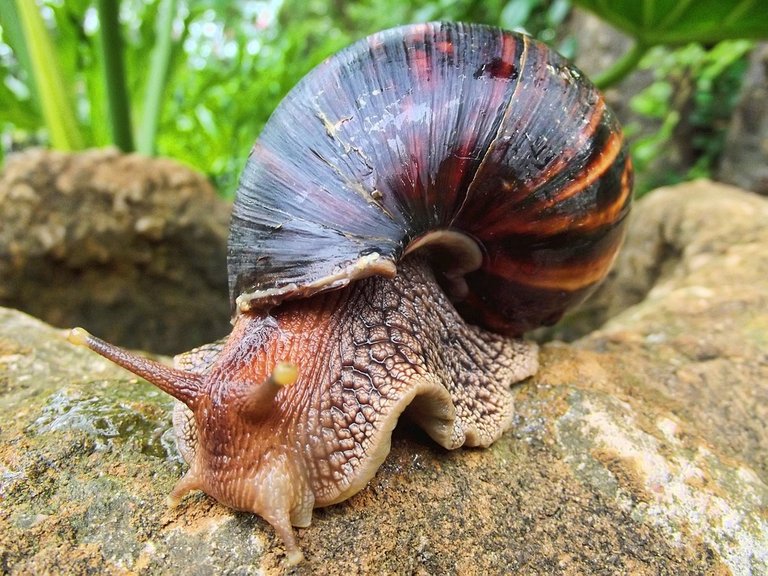
⬆️ This is not Gee Geronimo, the name of the snail that holds the Guinness World Record. The pictures of him aren't free but you can look them up. Anyway, it's a pretty large snail, isn't it?
Additionally, they are called African snails since some of them are native to Africa or have adapted to the African continent after hundreds of millions of years of evolution. In fact, if you ever want to think of some kind of super-ancient animal that has resisted extinction to the present day, you might think of snails. They will be older than most animals you can think of. Marine snails have been found in the fossil record dating back to the Lower Cambrian, that is, about 530 million years ago. What a living relic.
However, these snails can easily inhabit any region with a tropical climate, which is why they have become established in China, India, Pacific islands and now in South America. These large snails in their natural habitat proliferate in a controlled manner and are a valuable source of protein for many animals, thus playing an ecological role in the maintenance of the food chain.
So, what's wrong with the snail?
To an average person it may seem logical or unsurprising that the mosquito is the most lethal animal in the world, due to the diseases it transmits, notably malaria. For many, however, it does come as a surprise to learn that the seemingly innocent snail is, in fact, among the top 10 deadliest animals that kill humans annually. This is because they are carriers of the parasite Schistosoma mansoni, which causes Schistosomiasis, a disease that kills thousands of people worldwide every year, with a peak of at least 200,000 deaths in 2000 alone, according to the World Health Organization, easily making the snail the second most deadly animal worldwide at that time.
As a curious note for discussion with science nerds, Schistosoma is a flatworm that uses the snail as a temporary host in its complex life cycle. Within it, the parasite reproduces asexually in an exponential manner and then leaves the snail to search for its next host, which includes birds, reptiles, mammals, and thus humans. The trematode itself is classified within the kingdom Animalia, so it is considered an "animal". This being so, it can be argued that technically the flatworm itself has been the second deadliest animal in the world and not the snail.
In addition, the giant African snail, specifically, is also a carrier of at least eight parasites that cause serious diseases in humans and other animals, some of which can even lead to death, such as meningitis and meningoencephalitis, etc. This is because parasites like to infect hosts to be eaten and snails are in the middle of the food chain, being the favorite food of many animals, including birds. So think twice before eating a dish of snails.
Finally, it is worth mentioning that African snails, being an exotic species, can cause serious ecological problems when introduced into another environment and are therefore recognized as an invasive species. They can make animals that interact with them sick and, lacking effective natural predators in the area, they can proliferate uncontrollably. In addition, they can feed on all types of plants and thus cause significant agricultural damage. Even in the Simpsons they echoed how alarming the furtive entry of an exotic species into an ecosystem can be.

⬆️ And this is how that episode ends.
The African snail in Venezuela recently
Unfortunately, specialized sites and articles by biologists examining and documenting the cases more professionally are not abundant in the country, but there is this project Caracol Gigante Africano (Lissachatina fulica) en Venezuela, hosted on INaturalist.org and in which we can find information about it and a photo gallery of higher quality.
I invite you to visit it, since despite the abundant news, complaints and reports of sightings of the animal, most of the photos and videos available out there are amateur. Also, for better or worse, the African snail is not known to have spread to exactly the region where I live, so I cannot take first hand photos.
According to that site:
The project was created with the objective of contributing to the control, mitigation and eradication of this species in our country through the collection of information and biological data for its analysis and classification..
They've also created the following infographic:

⬆️ The infographic is evidently in Spanish since its target is the Venezuelan population. It teaches how to distinguish between the invasive species and the native ("criolla") species. It also offers instructions on how to get rid of the animal.
For his part, José Sandoval, president of the organization Mapache EcoAventura, has declared to the press that these African snails have recently reached the magnitude of a pest due to the unusually abundant rains that have affected the country lately, which has apparently favored their multiplication.
He also adds that they have a high reproductive capacity (they lay about 600 eggs every 15 days) and can live up to 6 years, so in short it will be very difficult to eradicate them. He also points out that they are voracious animals and will damage native vegetation and affect crops, not to mention the serious health problems they can cause.
On its Twitter account, the NGO Azul Ambientalista (@fundacionazul) has published the following video demonstrating the overabundance of the African snail in the Venezuelan city of Maracaibo.
In summary
We have seen that the giant African snail, despite being a group of animals with a long and successful evolutionary history and with an ecological role to play, can cause several important health and environmental problems once they leave the borders of their natural habitat, becoming invasive species and as such, pests. We have seen that there are organizations that recognize them as such and try to eradicate them, so it seems that their extermination is justified.
I am afraid that for some the justification may require an extra level of argumentation, something on a philosophical level. Likewise, the methods of killing them raise additional questions, involving ethics, science and urban myths. We will be addressing these issues in the next installment.
Notes
- Most of the sources used for this article have been referenced between the lines.
- The cover image was created from free or permissively licensed images that have in turn been attributed in the content of the post.
- Unless otherwise noted, the images in this article are in the public domain or are mine.
- Note to the curators/moderators of Hiver Learners: this is my first post in the community. If I have omitted any community rules, please inform me and help me fix it. Thanks.
